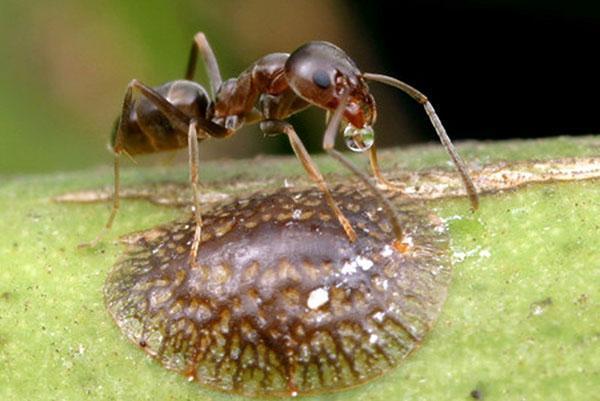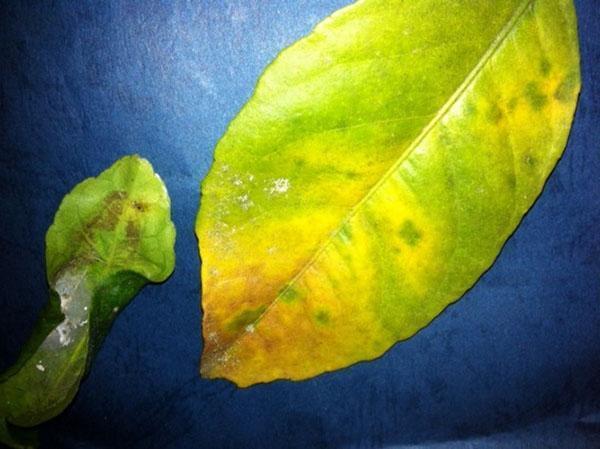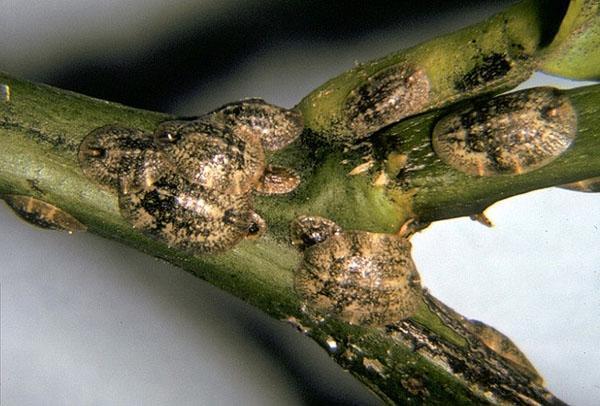How to get rid of scale insects on lemon and other plant enemies
 Until recently, a healthy lemon tree weakens and grows worse, the leaves on young shoots become smaller. With such symptoms, it is time for the owner of the plant to think about what the cause is the scale insect on the lemon, and how to get rid of the uninvited guest?
Until recently, a healthy lemon tree weakens and grows worse, the leaves on young shoots become smaller. With such symptoms, it is time for the owner of the plant to think about what the cause is the scale insect on the lemon, and how to get rid of the uninvited guest?
How to identify the presence of this pest on a house tree? Unlike other crawling or flying insects, the adult scale insect is practically motionless. But this does not prevent her from causing serious damage to a particularly young plant.
At first glance, it is not easy to find a scale insect on a lemon, because it looks like a small waxy growth with a size of 3 to 5 mm. Depending on the type, pests are located on the back of the leaves, on lateral shoots and on the trunk, that is, wherever it is possible to firmly attach to the surface.
Without proper attention, scale insects on lemon multiply quickly and, sucking juices from shoots and leaves, weaken the plant.

- closes the stomata on the leaf plates and thereby disrupts the process of tissue respiration;
- becomes a breeding ground for the sooty fungus, whose presence is revealed by the characteristic black spots on leaf plates and young stems.
 Disruption of photosynthesis, nutritional depletion from an increasing number of pests, and the addition of concomitant infections are the main factors leading to yellowing, wilting and loss of foliage. The leaves are followed by the turn of green shoots. If lemon diseases join insects, the plant is threatened with death.
Disruption of photosynthesis, nutritional depletion from an increasing number of pests, and the addition of concomitant infections are the main factors leading to yellowing, wilting and loss of foliage. The leaves are followed by the turn of green shoots. If lemon diseases join insects, the plant is threatened with death.
 How to get rid of scale insects on lemon? A solid shield reliably hides the insect from the attentive eyes of a person, helps to camouflage and seriously complicates the fight against the pest. It is because of such armor that insecticide treatment does not give the desired results. In addition, several species, differing in size and external characteristics, parasitize at once on a room culture. Some of these pests are quarantine, but they can stay in the country with fruits or houseplants.
How to get rid of scale insects on lemon? A solid shield reliably hides the insect from the attentive eyes of a person, helps to camouflage and seriously complicates the fight against the pest. It is because of such armor that insecticide treatment does not give the desired results. In addition, several species, differing in size and external characteristics, parasitize at once on a room culture. Some of these pests are quarantine, but they can stay in the country with fruits or houseplants.
To get rid of the scale insects on lemon, it must be detected as early as possible and adult insects must be mechanically removed.
Pests settle in colonies located on the stems and the back of the leaves. Sometimes it is possible to identify scale insects on the ovaries. Therefore, these areas are especially thoroughly examined.
The attachment points of the scale insects on the lemon are wiped with an alcohol-containing liquid, and then the whole plant is treated with a systemic insecticide. One procedure is not enough. Since the plant can contain pests in varying degrees of development, the treatment is repeated a couple more times with an interval of 7-10 days.
As a preventive measure, the citrus grower should:
- monitor the cleanliness of the soil under the plant;
- cut off dead and weakened shoots in time, especially those attracting pests;
- treat cuts and other wounds with garden pitch;
- arrange a monthly quarantine for all new plants or crops that return to the windowsill from their summer "vacation" in the garden.
 Adhering to these simple rules, you can not only seriously reduce the risk of scabbards on the lemon, but also protect green pets from the attack of other dangerous insects:
Adhering to these simple rules, you can not only seriously reduce the risk of scabbards on the lemon, but also protect green pets from the attack of other dangerous insects:
- false shields;
- miner flies;
- aphids;
- gall flies;
- mealybugs;
- spider mite.
Violation of the conditions for keeping citrus fruits contributes to a decrease in growth rates, yellowing and falling foliage, and refusal of fruiting.
For example, excessive dryness of the air in the room leads to the reproduction of spider mites. A microscopic pest is no less dangerous than a scale insect on a lemon, but you can get rid of it in similar ways, using home remedies and modern acaricides. True, it is important to correct care errors.
 In addition to insects and mites, harmful fungi and pathogenic bacteria attack the health of lemon. These pathogens of lemon diseases are carried by drops of water, wind, or on healthy specimens from already infected plants. A significant role in the spread and rate of reproduction of microorganisms is influenced by the conditions of detention.
In addition to insects and mites, harmful fungi and pathogenic bacteria attack the health of lemon. These pathogens of lemon diseases are carried by drops of water, wind, or on healthy specimens from already infected plants. A significant role in the spread and rate of reproduction of microorganisms is influenced by the conditions of detention.
 And on the leaves and fruits of the affected lemon, brown, black or gray spots form, the tissues on which gradually die off:
And on the leaves and fruits of the affected lemon, brown, black or gray spots form, the tissues on which gradually die off:
- foliage withers and falls;
- shoots stop growing, become weak, unviable;
- fruits lose quality or fall off at the ovary stage.
 Diseases of home lemon, caused by pathogenic microflora and fungi, can be treated with fungicides, but it is very important to put in order the care of the crop and return it to proper conditions. To make homemade lemon recover faster after an illness, all buds and flowers, as well as unripe fruits, are removed from it. Be sure to carry out sanitary pruning, and after the completion of the treatment, they are fed.
Diseases of home lemon, caused by pathogenic microflora and fungi, can be treated with fungicides, but it is very important to put in order the care of the crop and return it to proper conditions. To make homemade lemon recover faster after an illness, all buds and flowers, as well as unripe fruits, are removed from it. Be sure to carry out sanitary pruning, and after the completion of the treatment, they are fed.
And if the lemon has gained color and is in the apartment, how to treat it from the shield?
The most effective method of dealing with the scale insect, regardless of the phase of plant development, is mechanical, that is, removing it by hand. Wipe the places where the pests are found with a cotton swab dipped in alcohol, and gently separate the shield with a toothpick. To prevent pests from falling into the pot, cover the soil around the bush with foil. Be prepared to repeat the procedure, especially if there are a lot of scale insects.
Hello! But what if the scabbard was found on the vaccine? How can you work so as not to ruin the vaccine itself? And small white grains also circulate on the trunk. I erased them with a cotton pad yesterday, but today they appeared again. What is it? There can be no spider mite - there are no cobwebs, and besides, the vaccine is covered with a bottle and there is high humidity, which the spider mite does not like.
It would be better to carefully separate the pest by hand, especially since no drug will give such an effect that the scabbard falls by itself. As for the white formations, it is possible that white rot has developed from the high humidity. Air the plant often. You can try spraying it with a fungicide.
“They are being formed”, not “converting,” I wanted to write.
And if the scale insect itself is not visible after being treated twice with alcohol, and the leaves on the lemon have become sticky again ... what to do?
Leaves can be sticky not only from scale insects, but also from aphids. You will have to apply a garlic infusion or soap solution, or some kind of fungicide.
I fought with the scabbard for 3 years. And spirotm, and households. soap, and mechanically removed it. Everything is useless! As a result, I was in the village, bought an ampoule of Aktar, there is 10 liters, I diluted an ampoule for 4 liters. Popshikala all the leaves from all sides, trunks and gave birth to the rest of the earth. As a result, already 2 months of this muck is gone !!! The flowers came to life! I have 2 cats, not a single cat was hurt. So, girls, the cheapest and most effective way! Aktara. PS work better with gloves)